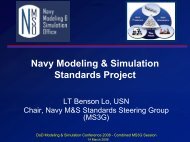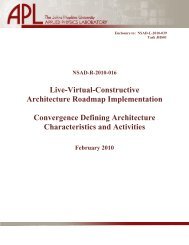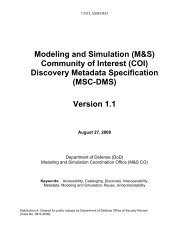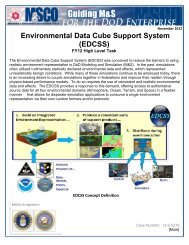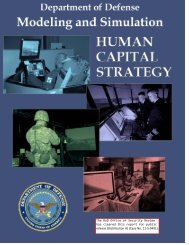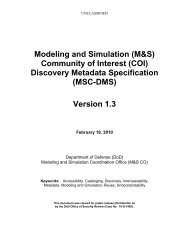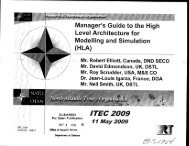LVCAR-I Convergence Final Report - Modeling & Simulation ...
LVCAR-I Convergence Final Report - Modeling & Simulation ...
LVCAR-I Convergence Final Report - Modeling & Simulation ...
You also want an ePaper? Increase the reach of your titles
YUMPU automatically turns print PDFs into web optimized ePapers that Google loves.
Live-Virtual-Constructive Architecture Roadmap Implementation,<br />
<strong>Convergence</strong> <strong>Final</strong> <strong>Report</strong><br />
Rather than make the current High Level Architecture (HLA) like the current Test and Training<br />
Enabling Architecture (TENA), the goal is to make future HLAs more like future TENAs.<br />
Subject matter experts (SMEs) from each architecture participated together on the<br />
<strong>LVCAR</strong>-CT. Each SME provided existing documentation resources and identified where in the<br />
documents to extract the key services and tools. This report describes the converged architecture<br />
envisioned by the <strong>LVCAR</strong>-CT in terms of how it would execute in a multi-architecture event.<br />
This converged execution contains (1) simulations that need not be aware that multiple<br />
architectures are in use, (2) parts of the support infrastructure of the legacy infrastructures, and<br />
(3) a common shared library for communication. The <strong>LVCAR</strong>-CT selected this concept because<br />
it requires no changes to the simulations (which are the area of greatest Department of Defense<br />
[DoD] investment). As a result, changes impact only a few infrastructure providers and require<br />
significantly less investment to achieve convergence.<br />
The <strong>LVCAR</strong>-CT SMEs completely affirm the <strong>LVCAR</strong> study findings with respect to<br />
architectural convergence. Defining a new architecture to which all simulation work would be<br />
migrated or selecting a single architecture at the expense of users of other solutions are<br />
unfeasible approaches from an engineering perspective and would lead to huge programmatic<br />
problems. Each of the four architectures possesses unique features, although the unique features<br />
are not required by all users. Expanding an existing architecture or building a new architecture to<br />
cover all requirements would be extremely difficult. The better engineering design uses a<br />
system-of-systems approach in which each architecture continues to support the existing user<br />
requirements and the architectures cooperate to exchange the information that is meaningful to<br />
all.<br />
1.1 REPORT FORMAT<br />
The report is constructed in four major parts: (a) the introduction; (b) the converged<br />
concept of execution; (c) the detailed activities needed for each architecture to adopt the<br />
converged concept, and (d) the recommended course of action and its return on investment<br />
(ROI). In addition, a list of references used in this report is provided in Appendix A. Appendix B<br />
provides a list of abbreviations and acronyms.<br />
1.2 CONVERGENCE APPROACH<br />
Working from the Architecture Reference Manual [Saunders et al., 2009], 2 the <strong>LVCAR</strong>-<br />
CT SMEs examined the runtime services provided by each of the legacy architectures. Services<br />
were classified as “architecture specific” where they did not need to be interoperable between<br />
architectures for effective multi-architecture events. These services would be available to<br />
simulations built for the legacy architecture, but nothing would be lost if they were not available<br />
to simulations built with other architectures. This classification does not reflect negatively on the<br />
2 References may be found in Appendix A.<br />
Page 3



